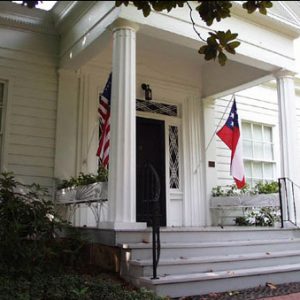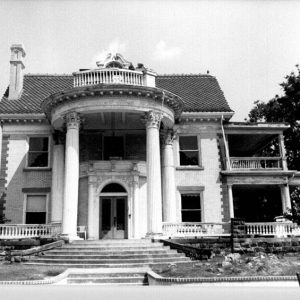calsfoundation@cals.org
The Blue and the Gray [TV miniseries]
The Blue and the Gray was a three-part television miniseries that was filmed primarily in northwestern Arkansas in 1981. It aired for three nights on the CBS television network in November 1982. The large cast included such actors as Lloyd Bridges, Colleen Dewhurst, Stacy Keach, Geraldine Page, Rip Torn, Robert Vaughn, and Paul Winfield. However, for many, the presence of legendary film star Gregory Peck, who portrayed President Abraham Lincoln, was the most memorable. Thousands of local citizens auditioned for roles as extras and positions as crew members, with many ultimately being hired. Harry Z. Thomason produced two episodes of the miniseries, and longtime western actor Lloyd “Arkansas Slim” Andrews had a minor speaking role.
Set during the Civil War, the title refers to the colors of the uniforms that were worn by the Union army of the North (blue) and those of the Confederate states in the South (gray). The plot revolves around two families, one living in Virginia and the other in Gettysburg, Pennsylvania, following their various viewpoints and the arc of their involvement with the war.
Although the fictional story is largely set in Virginia, the miniseries was filmed almost entirely in northwestern Arkansas. Towns in which the movie was filmed include Eureka Springs (Carroll County), Fayetteville (Washington County), Fort Smith (Sebastian County), and Van Buren (Crawford County). In addition, scenes were shot at the Prairie Grove Battlefield State Park in Prairie Grove (Washington County).
Both Arkansas and Kentucky were originally considered by the producers for shooting The Blue and the Gray. Anticipating the potential economic impact by the film company, local involvement by northwestern Arkansas businesses and civic groups ultimately brought the production to Arkansas. Cy Sutherland, architect and professor in the College of Architecture at the University of Arkansas (UA) in Fayetteville, worked with the production company to find appropriate historic buildings and sites in the area. These included the Angus McLeod House in Fort Smith and the Prairie Grove Battlefield State Park, where the Battle of Bull Run scenes were filmed. The park historian served as the military coordinator and technical advisor for the movie, and also arranged for more than 300 local Civil War reenactors to participate in the battlefield scenes.
At the University of Arkansas, scenes were shot at various locations on campus, including the historic building known as Old Main. It served as the setting for Ford’s Theatre, where Lincoln was assassinated. A scene involving cannon fire and cavalry charges was shot on the Markham Hill meadow, near Razorback Stadium. In addition, UA athletic director Frank Broyles portrayed one of Lincoln’s doctors in the deathbed scene, which was filmed at a former factory in Springdale (Washington and Benton counties).
The Circle-H Ranch on Highway 45 East was selected as the location of Lincoln delivering the Gettysburg Address. Scenes were also shot near the Routh-Bailey House on Fayetteville’s Old Wire Road. The house, dating from the 1840s, was in the background during a scene where enslaved people were seen taking refuge in the nearby woods. The Washington-Willow Historic District in Fayetteville was utilized for a number of shots. Many cubic yards of topsoil were brought in to cover the modern pavement on streets such as Washington Avenue. Fayetteville’s historic Headquarters House, which came under siege in 1863 during the war, was utilized in several scenes. With its period furniture, the home’s living room served as Lincoln’s cabinet chamber during discussion of the Emancipation Proclamation, and also for a meeting between President Lincoln and General Ulysses S. Grant the morning before Lincoln’s assassination.
Shooting the film took seventy-eight days. Between eleven and seventeen million dollars were spent in northwestern Arkansas. The final cut of The Blue and the Gray ran for 381 minutes when it was aired on television in 1982. A re-cut version available on video in 2005 ran for 296 minutes.
The film had its northwestern Arkansas premiere at the Malco Twin Cinema in Springdale. The star of the miniseries, Stacy Keach, attended along with a few other actors. Civil War reenactors fired a rifle salute as guests entered the theater. Afterward, a reception was held at the Rodeo of the Ozarks community center in Springdale.
The Arkansas crowd’s response was enthusiastic, although national reviews were mixed. The Blue and the Gray was nominated for four Primetime Emmy Awards in the areas of cinematography, editing, music, and sound editing. It won a 1983 People’s Choice Award for Favorite TV Mini-Series.
For additional information:
“The Blue and the Gray.” Internet Movie Database. https://www.imdb.com/title/tt0083387/?ref_=ttloc_loc_tt (accessed August 19, 2021).
O’Connor, John J. “TV View; ‘The Blue and the Gray’ Often Loses Sight of the Civil War.” New York Times, November 14, 1982, Section 2, p. 27. https://www.nytimes.com/1982/11/14/arts/tv-view-the-blue-and-the-gray-often-loses-sight-of-the-civil-war.html (accessed August 19, 2021).
Orton, Lisa. “Filming of ‘The Blue and the Gray’ in Fayetteville.” Markham Hill Moment of History, Ozarkia.net. http://www.ozarkia.net/mh/mhm015-BlueGrayMovie.html (accessed August 19, 2021).
“Silver Screen Memories Online Exhibit.” Shiloh Museum of Ozark History. https://shilohmuseum.org/project/silver-screen-memories/ (accessed August 19, 2021).
Sutherland, Cyrus A. “The Blue and the Gray.” Flashback 32 (August 1982): 1–17.
Nancy Hendricks
Garland County Historical Society


 Headquarters House Museum
Headquarters House Museum  Angus McLeod House
Angus McLeod House 



The scene with Lincoln on the train was filmed in Beavertown, AR–in my mom’s front yard. The scene of the burning of the railroad bridge was also filmed in Beavertown. By that time, my stepdad John Sybrandts was marshal of Beavertown, so he was handling a large part of security. I have tons of personal photos of background and setting.